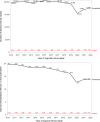Scheduled and urgent inguinal hernia repair in Ontario, Canada between 2010 and 2022: Population-based cross sectional analysis of trends and outcomes
- PMID: 38134127
- PMCID: PMC10745156
- DOI: 10.1371/journal.pone.0296258
Scheduled and urgent inguinal hernia repair in Ontario, Canada between 2010 and 2022: Population-based cross sectional analysis of trends and outcomes
Abstract
Introduction: We examine trends in inguinal hernia repairs with respect to the COVID-19 pandemic and secular trends in Ontario, Canada.
Methods: This was a retrospective cohort study. Hernia repairs performed January 1, 2010-December 31, 2022 were captured from health administrative inpatient and outpatient databases. Patients managed in three clinical settings were examined: public hospital in-patient, semi-private hospital in-patient (Shouldice Hospital), and public hospital out-patient. We examined the effect of the COVID-19 pandemic on surgical volumes, clinical setting, patient characteristics by setting, time from diagnosis until surgery, hospital length-of-stay, and patient outcomes (90-day readmissions, 1-year reoperations). We used multivariable logistic regression to examine whether patient outcomes were comparable between the COVID-19 period and the pre-pandemic period, adjusted sociodemographic and clinical factors. Shouldice Hospital is the only semi-private hospital in Ontario specializing in hernia repair (patients pay for the mandated admission, but not for the procedure).
Results: During the pandemic (March 2020-December 2022), there were 8,162 fewer (15%) scheduled inguinal hernia repairs than expected, but the age-sex standardized rate of urgent repairs remained unchanged. Shouldice Hospital performed more surgeries in the COVID-19 era than pre-pandemic and had a shorter average LOS by 24 hours, despite treating more patients with older age, higher ASA score [adjusted odds ratio (aOR) 2.13 (1.93-2.35) III vs I-II] and greater comorbidity [aOR 1.36 (1.08-1.70) for 2 vs none] than pre-pandemic. Patients treated in the COVID-19 era experienced a longer time until surgery, being the longest in 2022 (median 133 days). Ninety-day readmissions and 1-year reoperations were lower in the COVID-19 era and lower for patients receiving surgery at Shouldice Hospital.
Conclusion: During the COVID-19 pandemic, there were 8,162 fewer scheduled hernia repairs than expected, longer wait-times until surgery, shorter length-of-stay, and more patients with comorbidities, but outcomes were not worse compared with the pre-pandemic period.
Copyright: © 2023 Habbous et al. This is an open access article distributed under the terms of the Creative Commons Attribution License, which permits unrestricted use, distribution, and reproduction in any medium, provided the original author and source are credited.
Conflict of interest statement
The authors have declared that no competing interests exist.
Figures




References
-
- Gomez D, Nantais J, Telesnicki T, De Mestral C, Wilton AS, Stukel TA, et al.. A Population-based Analysis of the COVID-19 Generated Surgical Backlog and Associated Emergency Department Presentations for Inguinal Hernias and Gallstone Disease. Ann Surg. 2022. May 1;275(5):836–41. doi: 10.1097/SLA.0000000000005403 - DOI - PMC - PubMed
-
- Guillaumes S, Hidalgo NJ, Bachero I, Juvany M. Outpatient inguinal hernia repair in Spain: a population-based study of 1,163,039 patients-clinical and socioeconomic factors associated with the choice of day surgery. Updates Surg. 2022;75(1):65–75. doi: 10.1007/s13304-022-01407-1 - DOI - PMC - PubMed
MeSH terms
LinkOut - more resources
Full Text Sources
Medical

